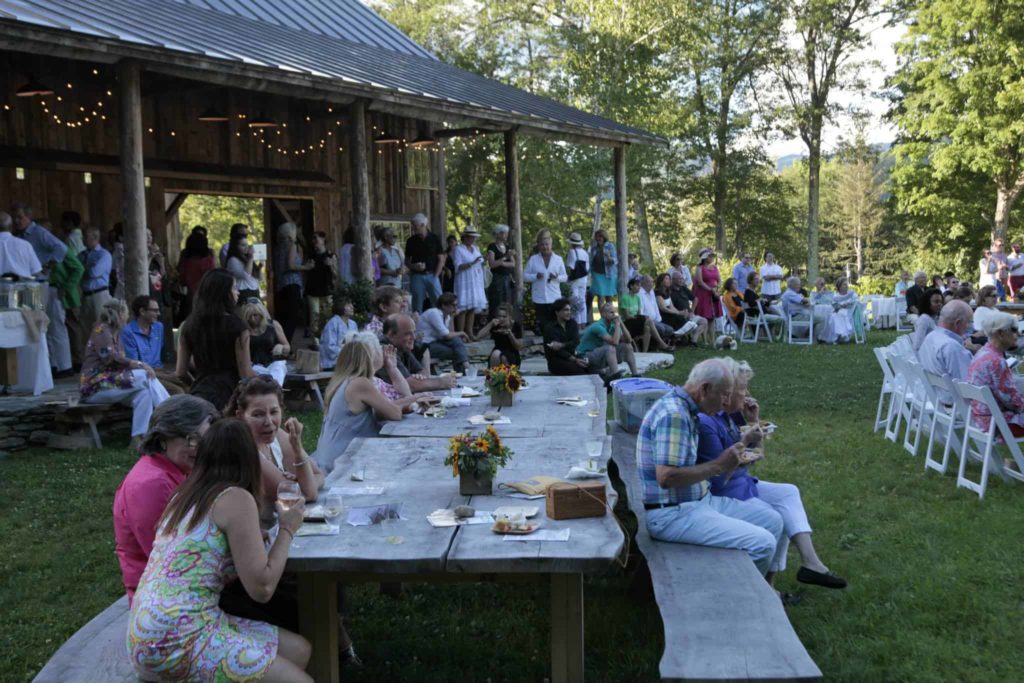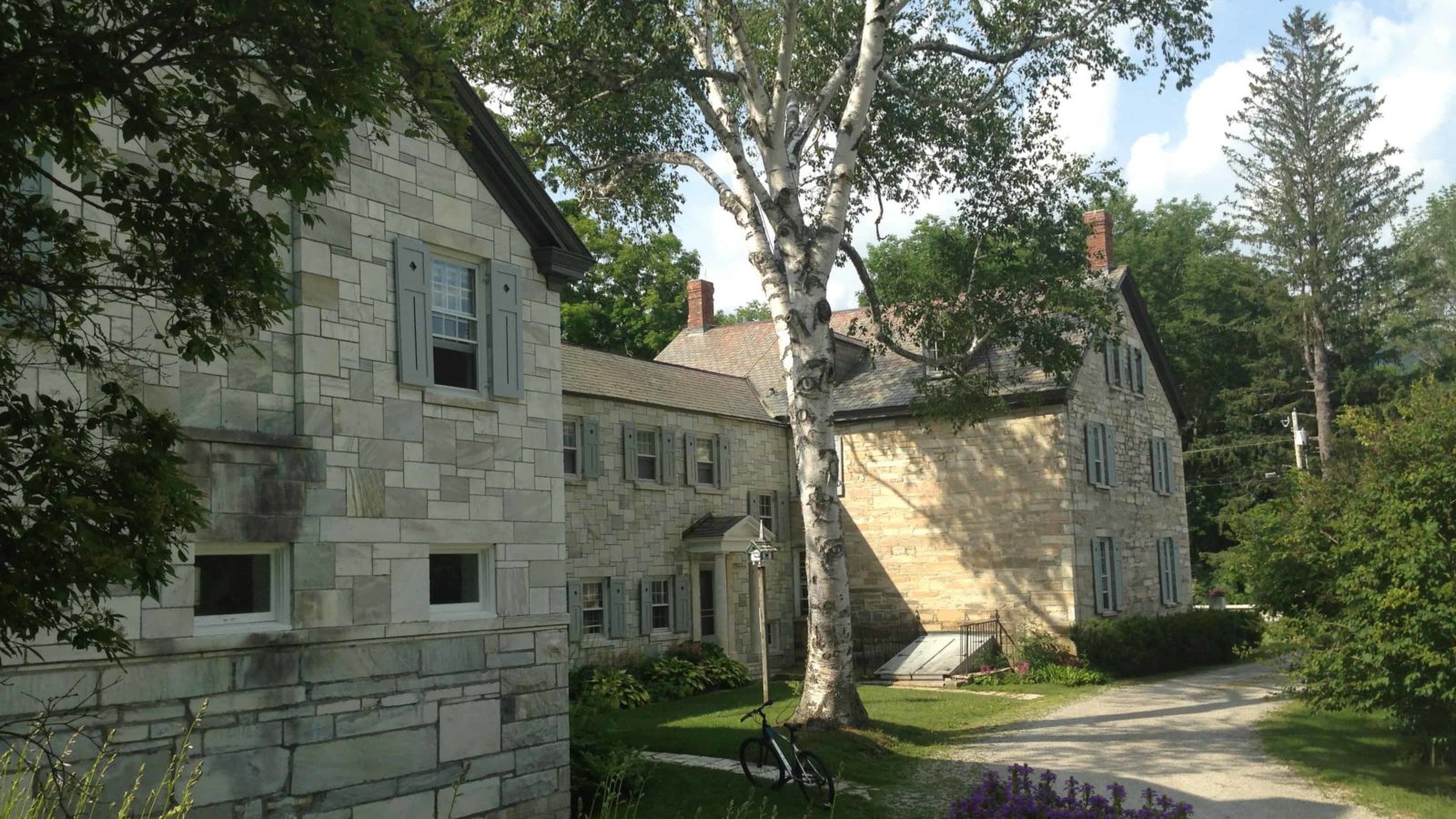Artists live here together for three-week stretches, working in studios around the house built of local stone, walking under the trees and talking on the lawns. They pick tomatoes out of the garden for dinner and cook and eat together. And on summer nights they present their work to anyone who wants to listen.
The Marble House Project in Dorset, Vt. has held artist residencies since the summer of 2015, Sarah Walko, director of arts programming, reflected as the Marble House wrapped up a set of fall workshops and planned for their next summer season. She has watched their artistic community growing, like a group of alumni, a family of artists. In these formative years, she said, a bare-bones staff and artists along for the journey end up building a lot of closeness.
They have plans to expand the residencies from April through October in 2016, she said, and broaden the series of talks and performances they began this summer.
“What people talk about or perform is so different, so diverse,” she said.

Artists and performers present their work at the Marble House. Press photo courtesy of Marble House Project
New York City writer, poet and translator Amir Parsa performed a new piece inspired by his bike rides from the Marble House to the center of Dorset. He has brought his work from the Queens Museum of Art to the Engendered Festival and the Uncommon Festival in New York and the Printemps des Poètes, the Sorbonne and the Conciergerie in Paris. At the Marble House, his bike ride became a fusion of many languages, weaving in English phrases he had overheard.
He wanted the audience to experience his bike ride as he experienced it, he said — the wind, the leaves, the speed, the sounds. He hoped they would reconnect with the strange wondrousness of language they took for granted, that they would see a place common to them in new ways. He took a risk, and he was nervous about the response, and the warmth of it, the audience’s excitement, has opened new pathways for him in the future.
He spoke warmly of his time at the Marble House.
“It’s absolutely amazing,” he said. “They have created ideal conditions for artists of any type, in any medium.”
He found thoughtful care in the design of the program and living space, and in what the Marble House did and did not ask from the residents — a deep respect for the artists. He could work here in ways that fit his own rhythms and aesthetics, He said. He could talk with people or work alone.
“They are generous to create this,” he said.

Musicians perform at the Marble House in Dorset, Vt. Photo courtesy of Marble House Project
The environment and structure of the day felt well thought-out. The artists had complete freedom, except that they gathered for dinner and took turns cooking. He would get up early, he said, and take a run or head into town.
Dorset is an old quarry town with stone sidewalks, white houses with green shutters, barns, picket fences. The people were friendly to him. The artists-in-residence joked that when they biked along the roads, people take such wide turns to keep out of their way, unlike New York City drivers.
He could swim in old quarries on the property — and then get back to work, finding a balance between writing and thinking about writing while getting exercise or walking around. He needed to be able to get up and walk away for awhile and still be working, he said. Here he had time to think and rethink, write and rewrite, to resolve obstacles and be immersed.
The environment inspired him to learn and create new things. He came hoping to work on an ongoing project, Manifestos of Multilingual Literature, he said. He often writes in more than one language. He was born in Iran and went to school in France before he came to the U.S. He speaks Persian, French and English and writes in all three, often moving between languages in one poem.
At the Marble House he performed in them. Walko had his performance clear in her head months later.
“He switches languages all the time,” she said, “and the story is so strong that even if you don’t speak that language you know what’s going on. He asked audience at one point what a poem was about, and even though they didn’t speak the language, they all knew.”
That performance has led him to think about his work in new ways. A performer can influence the audience with his voice and body, but a writer has words on a page. How can he invite readers to experience languages they may not know? In his writing he brings languages together, but he does not think of his poems as translations. How can he invite and encourage his readers?
“When something is spoken aloud, we may enjoy the sound without knowing the language,” he said. “We do that all the time in music.”
The Manifesto he brought to the marble House is a gathering of his ideas, he said, a statement of the theories behind his practice, and a literary and poetic work in itself.
He wants to bring genres and structures from one language into another. English does not have a lot of philosophical poetic prose, for example, but in French this form is fairly common. He wants to create new genres and forms, new relationships and experiences with words.
A poem on his website celebrates this kind of exploration: “je vole mon cerf des pics des minarets et je voie l’ange de la révolte avec moi mon compagnon des jeux dans les cieux …”
It translates: “I fly my kite from the points of the minarets and I see the angel of the revolt with me, my companion of the games in the skies: my new elixirs preserved to bury the tough linguistic migrations and the tyrannies of letters: … I was fighting the derivatives of the alphabet, I was climbing the walls, and on the frontiers of the possible … I invented new conjugations of ‘to be,’ new terminations of desire, new grammars of becoming …”
He does not call his work experimental, he added, because too often people have used that word dismissively.
“Often an audience, the public, even experts when they encounter something don’t know label it as ‘experimental’ as though that means it is incomplete,” he said.

Visitors gather for a country dinner at the Marble House. Photo courtesy of Marble House Project
The Marble House community has made him feel welcome. Vermont has a strong history of artists, Walko said, of independent thinkers and farmers, a rich history of creativity.
“So many writers live here,” she said. “We have a strong literary landscape.”
She feels an energy in Southern Vermont, in creative places and organizations like Hills Alive, the Weston Playhouse, Dorset Theatre Festival and the Southern Vermont Arts Center. The community has reached out to the Marble House and its visitors, and the Marble House has given its artists a sense of the area, not only the town but the region, museums and theaters and local businesses. They brought artists to Larson Farm in Welles, Vt., to meet Richard and Cynthia Larson, who raise grass-fed cattle.
“It’s all organic,” Walko said. “They have solar panels and massive compost piles. Cynthia always says you would never go to a doctor you haven’t met — she’s trying to encourage a culture where you know your farmer and where your food comes from and how animals are treated. She’s trying to get people to come to the farm and walking them around, teaching them.”
Marble House held a series of local farm talks, this summer, bringing farmers to meet the residents and the public and to talk about what they grow: popcorn, apples and cider at Yoder farm, sweet potatoes at Laughing Child Farm.
At their first farm talk, the young couple who run Studio Hill Farm in Shaftsbury and raise raise grass-fed turkeys explained how they came to take over the farm and how they learned to be farmers. Their aunt, who ran the farm before them, died of cancer, and they didn’t want the farm sold. They also thought she died as she did because of chemicals used on the farm, so they changed everything — no pesticides, no chemicals, a wholly different structure.
The Marble House feeds their visitors from their own gardens and brings these ideas of sustainability and stewardship into their own 38 acres of forest and grounds, vegetable gardens and formal gardens next to the house. The house was built 100 years ago, Walko said, and the Marble House now is building up the gardens for the next 100 years.
“This is not formal curated nature,” Walko said. “It’s about community and sustainability. It’s all organic.”
It takes time to work with soil, she said, but they have made progress. The staff, interns and residents harvest food for themselves, and the Marble House is planning to prepare large meals, which will begin by going into gardens and picking food.
Parsa found a compelling immediacy in the land and its cycles.
The Marble House has a chicken coop, and he learned about composting and feeding the chickens. Composting gives off heat and can help to keep the chickens warm in the winter, he said. The staff used old paper in the bottom of the coop, and he brought in drafts of his work to compost themselves into warmth and earth.

The Marble House serves dinner on a summer evening. Photo courtesy of Marble House Project
The translation of Amir Parsa‘s French verse above is my own.

